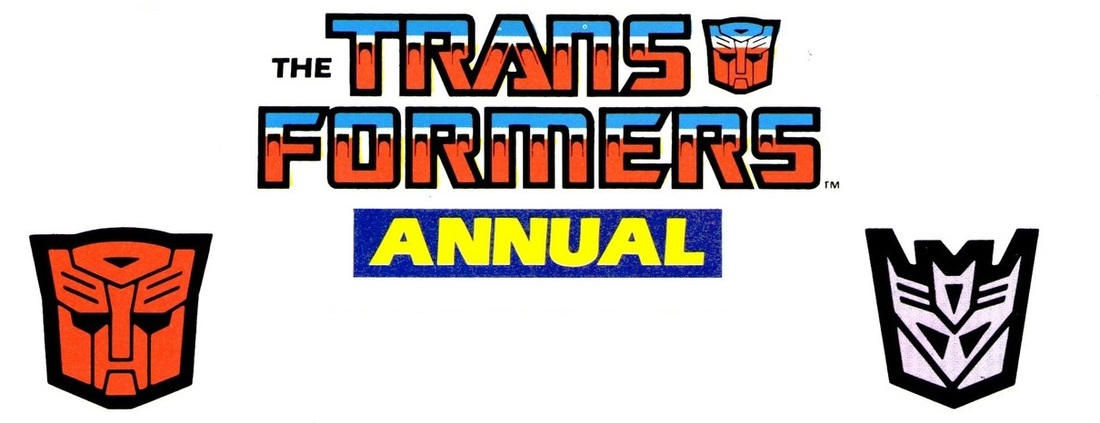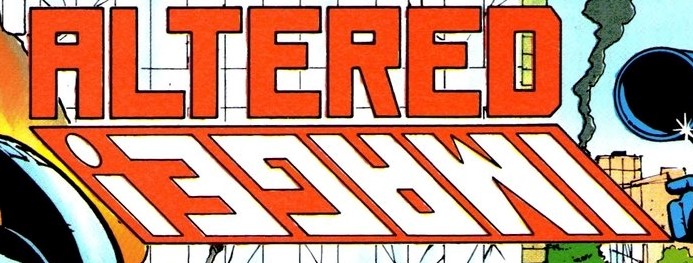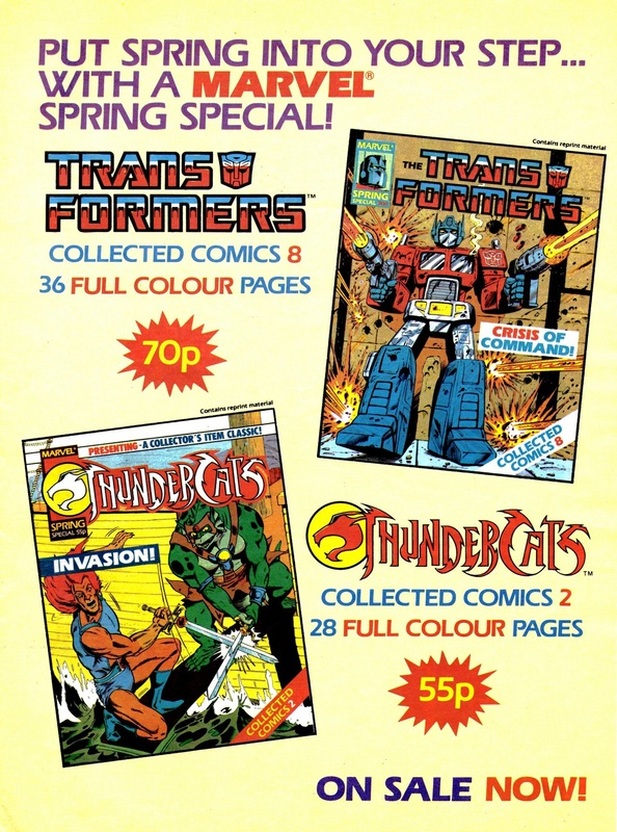I'm Starting With the Man in the Mirror. I'm Asking Him to Change His Ways.
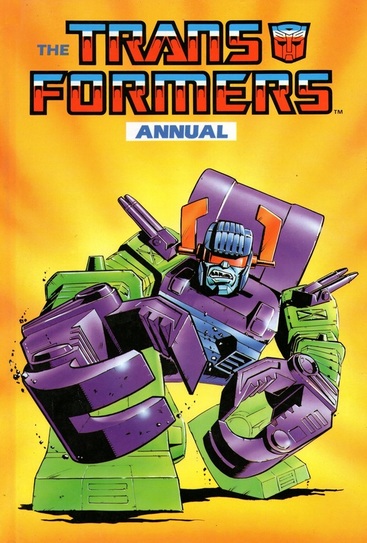
The Transformers Annual. 1988.
Comic Stories:
Altered !egamI
All in the Minds!
Peace.
Text Stories:
The Saga of the Transformers—So Far!
Prime Bomb! Part 1.
Prime Bomb! Part 2.
Right at this moment I’m beginning to wonder if I really am descended from this mindless lump of metal!
Of the seven Annuals Marvel produced, the 1988 book is by far and away my Annual. Though (as with the others I had as a kid) I believe it was an after the fact charity shop find, it was still the book I managed to get fairly soon after its release and one I read back and forth repeatedly. Even as an adult I can still just about recite the entire book from memory. For many people it’s the first two books that are the most cherished, but as far as I’m concerned this is the pinnacle of the range.
From a more objective viewpoint it does have one clear advantage over last year’s book. There the lead strip was the direct continuation of a story from the weekly that had to jump through some awkward hoops in order to work as both part 7 of Galvatron and the Volcano and something that could be read by children who either didn’t buy the comic or who didn’t remember a story from months before.
Here we instead get a more straightforward approach more akin to What’s in a Name?, the best strip from the 1987 book. The first two comics in this book contain key developments for the weekly, with the first also following up on Dry Run! However, despite concluding on a “The end...or is it?!?!” note designed to encourage people to check out the regular comic, each story manages to be successfully self contained in its own right. Those in the know get something extra, but those with no idea can still read this easily.
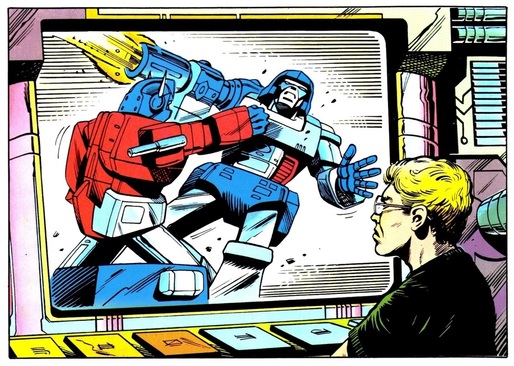 Is Prime preparing to knee Megatron in the balls there?
Is Prime preparing to knee Megatron in the balls there?
Things kick off with a feature that had to be sacrificed last year to make room for the Headmasters Saga: A narrative recap of the comic’s history. The Saga of the Transformers—So Far! (“Compiled” by Furman, who also edits the book under his Chris Francis pseudonym) is actually a sequel to the similar piece from the 1986 Annual as Adam Reynolds returns in the framing device.
After nearly being killed by the Decepticon computer, Adam has spent the last two years attempting to track down the Autobot’s base so he can carry on learning about the Cybertronian war. This is a task that has been made much easier by Grimlock launching the Ark into space and leaving equipment (Aunty?) behind unguarded in the volcano. Despite simply being a device to get to the recap, Furman puts some real effort into conveying Adam’s thirst for knowledge, and the description of his exploration of Mount St Hilary and the four desperate hours it takes him to climb the remaining computer terminal is extremely evocative.
The recap itself is nice and straightforward (though containing one absolute howler in claiming the Ark reawakened in 1982), though it takes an extra significance for me as this was the first time I ever encountered the bulk of this backstory. Diving head first into this history was a heady experience and I still firmly associate many of the early American stories with the images from UK stories that are repurposed (and recoloured) to represent them here. Most noticeably a fantastic Barry Kitson panel from Second Generation! of Shockwave decapitating Ratchet and Jazz that is meant to convey the end of issue 8 (yes, even if Ratchet surviving there is a major thing).
The surprise is the lack of mention of the British stories outside of the Galvatron arc. Prime and Megatron’s return to Cybertron is the only non-time travel related local story to warrant a description. At the very least you’d have expected the creation of the Special Teams to be covered, but that is not the case. The piece was clearly written around the same time Salvage! was being put together as that’s the most recent story mentioned—though as this book contains Lee Sullivan’s first art it might not have been more than scripted—with a very brief mention of the Throttlebot’s execution being the most recent American event. The arrival of the Headmasters on Earth is covered, but in such a vague way it feels it was done in a “This is going to happen but we don’t know how yet” way.
The framing device ends with Adam wondering if he could become a Headmaster, but this is the last we’ll see of him as next year’s Annual will use a completely different framing device. This is a shame as this gimmick has worked very well and made what could be a very dry piece much more interesting and readable.
After nearly being killed by the Decepticon computer, Adam has spent the last two years attempting to track down the Autobot’s base so he can carry on learning about the Cybertronian war. This is a task that has been made much easier by Grimlock launching the Ark into space and leaving equipment (Aunty?) behind unguarded in the volcano. Despite simply being a device to get to the recap, Furman puts some real effort into conveying Adam’s thirst for knowledge, and the description of his exploration of Mount St Hilary and the four desperate hours it takes him to climb the remaining computer terminal is extremely evocative.
The recap itself is nice and straightforward (though containing one absolute howler in claiming the Ark reawakened in 1982), though it takes an extra significance for me as this was the first time I ever encountered the bulk of this backstory. Diving head first into this history was a heady experience and I still firmly associate many of the early American stories with the images from UK stories that are repurposed (and recoloured) to represent them here. Most noticeably a fantastic Barry Kitson panel from Second Generation! of Shockwave decapitating Ratchet and Jazz that is meant to convey the end of issue 8 (yes, even if Ratchet surviving there is a major thing).
The surprise is the lack of mention of the British stories outside of the Galvatron arc. Prime and Megatron’s return to Cybertron is the only non-time travel related local story to warrant a description. At the very least you’d have expected the creation of the Special Teams to be covered, but that is not the case. The piece was clearly written around the same time Salvage! was being put together as that’s the most recent story mentioned—though as this book contains Lee Sullivan’s first art it might not have been more than scripted—with a very brief mention of the Throttlebot’s execution being the most recent American event. The arrival of the Headmasters on Earth is covered, but in such a vague way it feels it was done in a “This is going to happen but we don’t know how yet” way.
The framing device ends with Adam wondering if he could become a Headmaster, but this is the last we’ll see of him as next year’s Annual will use a completely different framing device. This is a shame as this gimmick has worked very well and made what could be a very dry piece much more interesting and readable.
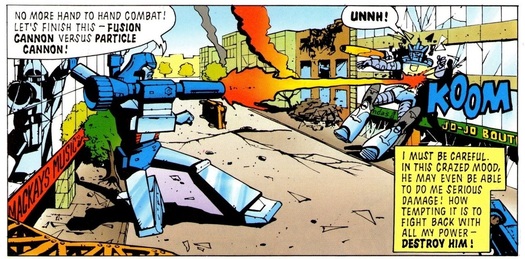 Odd how Megatron will wind up the sane one in this pairing.
Odd how Megatron will wind up the sane one in this pairing.
The real centrepiece of the Annual comes in the first comic story, Altered Image! (the fun in the contents above being the result of the logo literally being mirrored). This is a moment people would have been waiting two years for with baited breath: Galvatron Vs. Megatron. It’s easy to overlook how significant this was considering it has happened so often since—even between versions of the two characters who aren’t related—but this is effectively the equivalent of a multi-Doctor Who story and those are always fun.
Furman wisely realises that what people are going to want from this is action, so the preamble is minimal. Galvatron—in one of his more sane and introspective moods in keeping with his portrayal in Enemy Action!—knows Shockwave has gotten hold of and brainwashed Megatron and so has deliberately lured him into a town for a chat. His musings on his relationship with Megatron carry on through the fight that follows and makes for the heart of the story as he wonders about just how stupid his past self seems and what he must do to beat him down enough to get him to listen. It’s the old idea that if you met yourself as a young man you’d think you’re a dick, and it’s well played here.
The fight—instigated by the generally pissed off Megatron—is in and of itself awesome. As noted above, this was the first sequential work Lee Sullivan did for the book and it’s actually superior to his first published work in Salvage!, possibly because Annual work had a longer lead in time. The brutal way they throw each other into buildings is some of the most memorable action we’ve had since Geoff Senior left the book, helped by Sullivan getting some fantastic facial expressions in there. He’s admitted to basing Galvatron on Jack Nicholson and that suits the Decepticon very well.
There’s also a lovingly realised flashback to the creation of Galvatron in what is the first of many, many homages to the transformation sequence in that film. Sullivan also uses reflections in a thoughtful way to play up the mirror image aspects of the story.
The icing though comes from how Galvatron convinces Megatron to team up with him. Not by explaining his backstory, not by beating him into submission. No, Megatron decides Galvatron might be a useful ally (even if he doubts they’re the same person) after finding out what happened to Starscream in 2006. Which just brings him out in hysterics.
It also shows that Furman can handle a six page story perfectly well, and that the difficult transition the weekly is about to undergo is simply down to lack of preparation time rather than unfamiliarity with working within the length.
Furman wisely realises that what people are going to want from this is action, so the preamble is minimal. Galvatron—in one of his more sane and introspective moods in keeping with his portrayal in Enemy Action!—knows Shockwave has gotten hold of and brainwashed Megatron and so has deliberately lured him into a town for a chat. His musings on his relationship with Megatron carry on through the fight that follows and makes for the heart of the story as he wonders about just how stupid his past self seems and what he must do to beat him down enough to get him to listen. It’s the old idea that if you met yourself as a young man you’d think you’re a dick, and it’s well played here.
The fight—instigated by the generally pissed off Megatron—is in and of itself awesome. As noted above, this was the first sequential work Lee Sullivan did for the book and it’s actually superior to his first published work in Salvage!, possibly because Annual work had a longer lead in time. The brutal way they throw each other into buildings is some of the most memorable action we’ve had since Geoff Senior left the book, helped by Sullivan getting some fantastic facial expressions in there. He’s admitted to basing Galvatron on Jack Nicholson and that suits the Decepticon very well.
There’s also a lovingly realised flashback to the creation of Galvatron in what is the first of many, many homages to the transformation sequence in that film. Sullivan also uses reflections in a thoughtful way to play up the mirror image aspects of the story.
The icing though comes from how Galvatron convinces Megatron to team up with him. Not by explaining his backstory, not by beating him into submission. No, Megatron decides Galvatron might be a useful ally (even if he doubts they’re the same person) after finding out what happened to Starscream in 2006. Which just brings him out in hysterics.
It also shows that Furman can handle a six page story perfectly well, and that the difficult transition the weekly is about to undergo is simply down to lack of preparation time rather than unfamiliarity with working within the length.
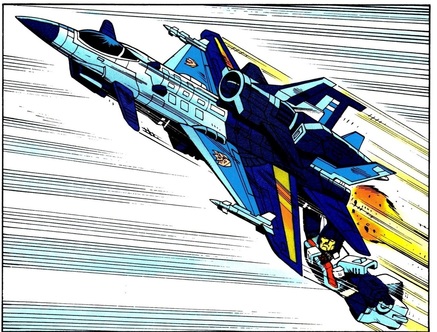 Looks like he GOT AWAY. He he.
Looks like he GOT AWAY. He he.
The text story effectively sets the standard for the final three Annuals, rather than multiple stories we instead get one super sized adventure in two parts. The first half of Prime Bomb! by Ian Rimmer explores an idea from Budiansky’s work that I don’t think anyone would have expected to see again.
The three smaller Powermasters have been given the job of protecting Alternate Reality Inc. to make sure that Prime’s floppy disc (as the original was taken to Nebulos, how many copies did Zachary make?) doesn’t fall into the wrong hands. See, I said Prime would soon start finding excuses to stop them hanging out with him. This is effectively THE Powermaster story, and though it’s broad and very much taken from their tec specs (Slapdash even gets stuck in vehicle mode after forgetting his partner) it’s the best showing the three of them will ever have. Though Joyride still remains pretty unmemorable.
Though they’re dismissive of the assignment and complete dicks to the Protectobots they’re relieving, things soon heat up as Dreadwind and Darkwing attack. Rimmer conveys the action well and makes sure to include the Nebulons as well for a battle on multiple scales. The Decepticons get the disc, but Getaway manages to hitch a ride with them as they flee. With the reveal that the Combaticons have successfully stolen advanced Earth weaponry at the same time the question becomes what Scorponok will do with these different assets and will Getaway survive it?
This first half rocks along with various nice set pieces (I especially like poor old Defensor getting taken down by Brawl from behind after hesitating over shooting the Decepticons with Getaway hanging off them) that—though clearly aimed slightly younger than the comic strips—still makes for a solid fun opening.
The three smaller Powermasters have been given the job of protecting Alternate Reality Inc. to make sure that Prime’s floppy disc (as the original was taken to Nebulos, how many copies did Zachary make?) doesn’t fall into the wrong hands. See, I said Prime would soon start finding excuses to stop them hanging out with him. This is effectively THE Powermaster story, and though it’s broad and very much taken from their tec specs (Slapdash even gets stuck in vehicle mode after forgetting his partner) it’s the best showing the three of them will ever have. Though Joyride still remains pretty unmemorable.
Though they’re dismissive of the assignment and complete dicks to the Protectobots they’re relieving, things soon heat up as Dreadwind and Darkwing attack. Rimmer conveys the action well and makes sure to include the Nebulons as well for a battle on multiple scales. The Decepticons get the disc, but Getaway manages to hitch a ride with them as they flee. With the reveal that the Combaticons have successfully stolen advanced Earth weaponry at the same time the question becomes what Scorponok will do with these different assets and will Getaway survive it?
This first half rocks along with various nice set pieces (I especially like poor old Defensor getting taken down by Brawl from behind after hesitating over shooting the Decepticons with Getaway hanging off them) that—though clearly aimed slightly younger than the comic strips—still makes for a solid fun opening.
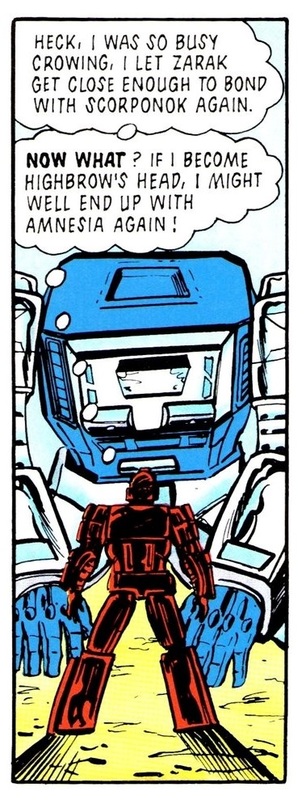 Just a nice moody panel from Reed rather than one of the obvious Crazy Shit ones.
Just a nice moody panel from Reed rather than one of the obvious Crazy Shit ones.
The second comic, All in the Minds!, is in theory also important in setting up a key plot point for Time Wars. Sadly, as will so often be the case with that story, how it reads in isolation and how it reads in the wider context are two different things.
By itself, this is a smart fast paced story reviving the Scorponok/Highbrow rivalry from Worlds Apart! to great effect. We open with Highbrow trying—and failing—to outfight the Decepticon leader as he flees through a forest (the panel of him trying to block up Scorpy’s claw with a tree trunk and failing utterly is brilliant) before using a gun overload as cover to fly off pursued by the Horrorcons. He manages to take out Apeface, but Mindwipe simply swoops up and hypnotises him.
The idea is simple: To give Highbrow amnesia and set him against his fellow Autobots. At first the plan seems to work, and the sequence of Scoropnok and Mindwipe trying to be nice and pretend friendship with “Decepticon” Highbrow is genuinely funny. However, when Scorponok tries to put the uncertain Autobot at ease by suggesting they hang out in their Nebulon forms, it turns out Gort’s mind is still his own, resulting in a top panel of him decking Vorath. Zarak manages to reform with Scorponok however, and so the little guy has the choice of either being squashed or becoming a brainwashed head again.
Of course (and you’d have thought Scorponok would have learnt this lesson by now), two brains are better than one so Gort is able to overcome the conditioning and has Highbrow offer to remove an unsightly lump from Scorponok’s shoulders... his head. Leaving him walking off with the revelation that those antenna make for great handles.
Furman is clearly having fun here playing up on Cold War era brainwashing stories—Scorponok and Mindwipe even call Highbrow “Comrade”—and Dan Reed gets some memorable imagery out of both Mindwipe and the decapitation.
But... This is a story that will go nowhere and take up valuable space in Time Wars that could have better been given over to more essential things. In that wider context it’s actually quite annoying, and that’s a shame.
By itself, this is a smart fast paced story reviving the Scorponok/Highbrow rivalry from Worlds Apart! to great effect. We open with Highbrow trying—and failing—to outfight the Decepticon leader as he flees through a forest (the panel of him trying to block up Scorpy’s claw with a tree trunk and failing utterly is brilliant) before using a gun overload as cover to fly off pursued by the Horrorcons. He manages to take out Apeface, but Mindwipe simply swoops up and hypnotises him.
The idea is simple: To give Highbrow amnesia and set him against his fellow Autobots. At first the plan seems to work, and the sequence of Scoropnok and Mindwipe trying to be nice and pretend friendship with “Decepticon” Highbrow is genuinely funny. However, when Scorponok tries to put the uncertain Autobot at ease by suggesting they hang out in their Nebulon forms, it turns out Gort’s mind is still his own, resulting in a top panel of him decking Vorath. Zarak manages to reform with Scorponok however, and so the little guy has the choice of either being squashed or becoming a brainwashed head again.
Of course (and you’d have thought Scorponok would have learnt this lesson by now), two brains are better than one so Gort is able to overcome the conditioning and has Highbrow offer to remove an unsightly lump from Scorponok’s shoulders... his head. Leaving him walking off with the revelation that those antenna make for great handles.
Furman is clearly having fun here playing up on Cold War era brainwashing stories—Scorponok and Mindwipe even call Highbrow “Comrade”—and Dan Reed gets some memorable imagery out of both Mindwipe and the decapitation.
But... This is a story that will go nowhere and take up valuable space in Time Wars that could have better been given over to more essential things. In that wider context it’s actually quite annoying, and that’s a shame.
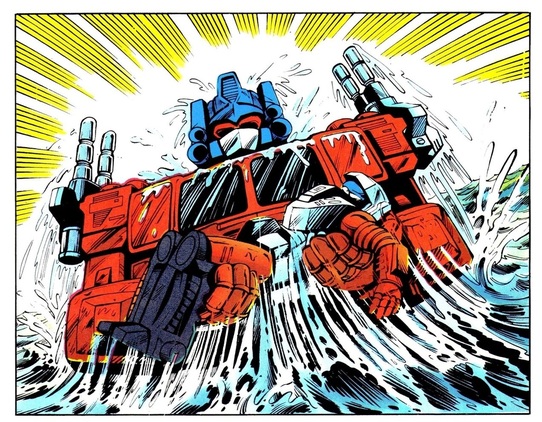 HiQ is the width of a truck it seems.
HiQ is the width of a truck it seems.
The conclusion of Prime Bomb! is effectively made of two plots. The first sees Getaway using his escapology skills to successfully get out of his cell in the Decepticon base (if only Scorponok had thought to string him up without his arms and legs. James Roberts has basically ruined all prior Getaway fiction) and discovering that the ‘Cons have combined the Prime disc with the advanced human ABC computer to create a smart missile that can hunt Optimus down anywhere. This results in a nice scene of Getaway trying to talk to ABC machine to machine that turns out to be more important later.
The other half sees Prime, once alerted by the escaped Getaway, deciding that this is all his fault for having kept the disc around for purely nostalgic reasons over his regard for the computer characters he died for. This is a nice touch of characterisation, leading into a massive cross-country chase filled with some memorable set pieces such as HiQ nearly drowning. Despite his best efforts, Prime can’t outrun himself and seems doomed...until the missile turns out to be a dud. It seems Getaway had actually gotten through to ABC, convincing the first ever human built sentient computer to make a choice for itself and not kill Prime. Optimus is distraught by this as he knows Scorponok will be killing the computer for its failure, meaning he has been responsible for both the creation of new life and its death.
This continues the fast fun of the first half, but adds a more thoughtful side that takes advantage of old continuity (whilst not really fitting into current continuity, there’s no real moment where all these characters are working on Earth at the same time) to great effect. It tends to be rather overlooked amongst the text stories, but is well worth your time.
The other half sees Prime, once alerted by the escaped Getaway, deciding that this is all his fault for having kept the disc around for purely nostalgic reasons over his regard for the computer characters he died for. This is a nice touch of characterisation, leading into a massive cross-country chase filled with some memorable set pieces such as HiQ nearly drowning. Despite his best efforts, Prime can’t outrun himself and seems doomed...until the missile turns out to be a dud. It seems Getaway had actually gotten through to ABC, convincing the first ever human built sentient computer to make a choice for itself and not kill Prime. Optimus is distraught by this as he knows Scorponok will be killing the computer for its failure, meaning he has been responsible for both the creation of new life and its death.
This continues the fast fun of the first half, but adds a more thoughtful side that takes advantage of old continuity (whilst not really fitting into current continuity, there’s no real moment where all these characters are working on Earth at the same time) to great effect. It tends to be rather overlooked amongst the text stories, but is well worth your time.
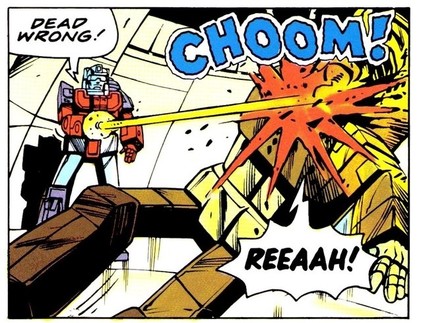 Where we're going, we don't need Roadbuster.
Where we're going, we don't need Roadbuster.
The final comic strip, Peace, is something of an oddity. Officially outside of continuity (something that will confuse many readers. Though with the amount of deaths and resurrections across the series there’s nothing really to say this couldn’t be the final ever Marvel story) it’s a parable on the futility of war. Written by Richard Starkings under the name Richard Allen it’s set in 2510 and sees the Autobots finally seemingly kill all the Decepticons.
Rodimus calls a meeting (attended by all of a dozen Autobots) to declare the war over and pass leadership to Springer as he’s now oh so tired. However, one Decepticon is left amongst their ranks in the shape of deep penetration agent Triton (bit of mistake on his part to use a name that looks like someone mucked about with the word “Traitor”), who doesn’t plant to let things end like this. Quickly doing his Iago routine he declares Ultra Magnus should lead, causing an argument between the Wreckers and Technobots culminating in Scattershot killing Roadbuster. Then Sandstorm kills Triton for starting all this (with it turning out his Autobrand wasn’t very securely attached over his Decepticon symbol) and all hell breaks lose as the war starts again.
It might seem Triton has it too easy in turning Autobot against Autobot, but that’s rather the point. These characters have been fighting so long it doesn’t take much and it’s a theme the series will return to time and time again (a deep cover agent causing trouble for Rodimus suggests an influence on aspects of Eugenesis as well). The final panel of Rodimus on his knees surrounded by his own troops killing one another is one of the bleakest conclusions to any Transformers story, helped by memorable Robin Smith art (again in his first sequential work).
Rodimus calls a meeting (attended by all of a dozen Autobots) to declare the war over and pass leadership to Springer as he’s now oh so tired. However, one Decepticon is left amongst their ranks in the shape of deep penetration agent Triton (bit of mistake on his part to use a name that looks like someone mucked about with the word “Traitor”), who doesn’t plant to let things end like this. Quickly doing his Iago routine he declares Ultra Magnus should lead, causing an argument between the Wreckers and Technobots culminating in Scattershot killing Roadbuster. Then Sandstorm kills Triton for starting all this (with it turning out his Autobrand wasn’t very securely attached over his Decepticon symbol) and all hell breaks lose as the war starts again.
It might seem Triton has it too easy in turning Autobot against Autobot, but that’s rather the point. These characters have been fighting so long it doesn’t take much and it’s a theme the series will return to time and time again (a deep cover agent causing trouble for Rodimus suggests an influence on aspects of Eugenesis as well). The final panel of Rodimus on his knees surrounded by his own troops killing one another is one of the bleakest conclusions to any Transformers story, helped by memorable Robin Smith art (again in his first sequential work).
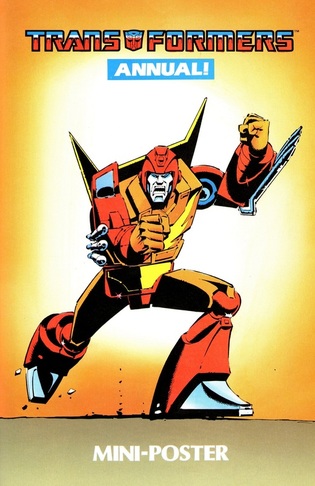 Other boys in the 1980's had Sam Fox posters on their wall. James Roberts had this.
Other boys in the 1980's had Sam Fox posters on their wall. James Roberts had this.
The Annual’s bonus features are far more extensive this year. Three old covers are turned into posters, with Geoff Senior’s issue 113 work unsurprisingly being the most striking. We also get AtoZ’s on all of the Seacons using their toybox art.
The most memorable bonus for me though is the Puzzle Pathway, a fiendish quiz of 20 questions of varying types covering anagrams, recognising characters, answers for which you have to get the question and just straightforward posers. It’s huge fun and thought through well, and the use of an image from Salvage! on the answers page where Ultra Magnus struggles to recognise the red and blue robot in question 10 is rather wonderful as well.
Overall, this is an extremely well put together package, containing four stories that range from good to brilliant and some good added value. Any child who got this for Christmas and wasn’t already a regular reader would likely have signed up at once.
Now, to conclude my wrap up of 1988, click below for this year’s Collected Comics.
TRANSFORMERS UNIVERSE
1988
COMMENT
The most memorable bonus for me though is the Puzzle Pathway, a fiendish quiz of 20 questions of varying types covering anagrams, recognising characters, answers for which you have to get the question and just straightforward posers. It’s huge fun and thought through well, and the use of an image from Salvage! on the answers page where Ultra Magnus struggles to recognise the red and blue robot in question 10 is rather wonderful as well.
Overall, this is an extremely well put together package, containing four stories that range from good to brilliant and some good added value. Any child who got this for Christmas and wasn’t already a regular reader would likely have signed up at once.
Now, to conclude my wrap up of 1988, click below for this year’s Collected Comics.
TRANSFORMERS UNIVERSE
1988
COMMENT
